Contemporary craft movements address the growing demand for sustainability and community engagement in art. This article explores their historical context, highlights key figures like Grayson Perry, and examines their global impact. It also discusses the challenges these movements face, including commercialization and the influence of technology. Lastly, emerging trends such as eco-conscious practices and the revival of traditional techniques will be analyzed.
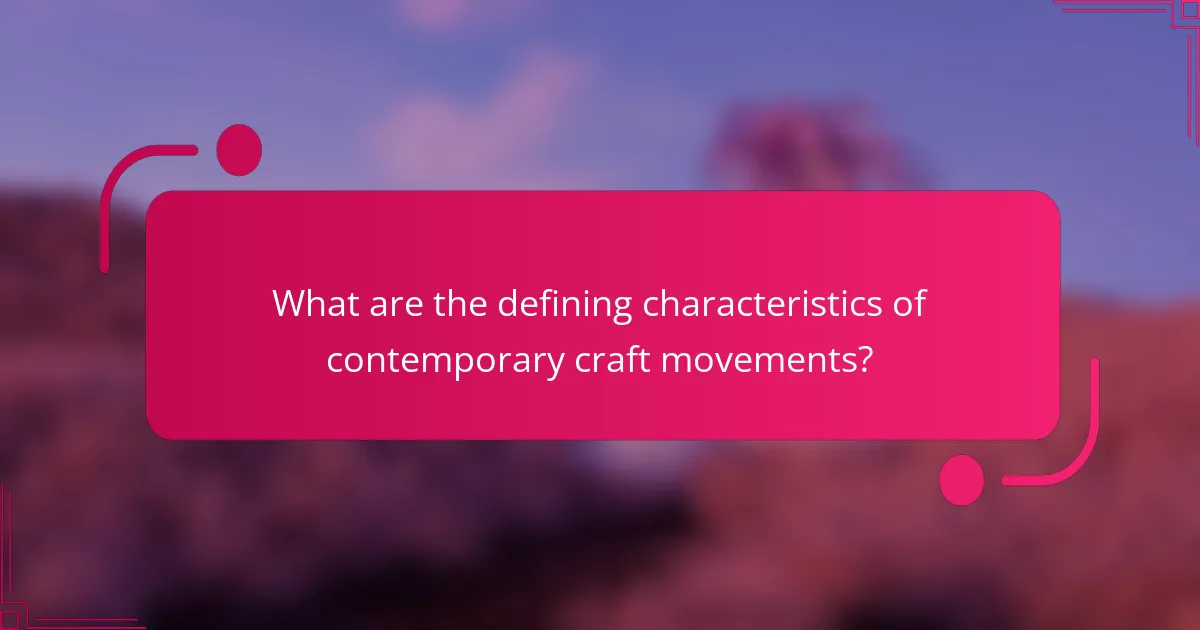
What are the defining characteristics of contemporary craft movements?
Contemporary craft movements are defined by their emphasis on sustainability, community engagement, and the fusion of traditional techniques with modern aesthetics. These movements often prioritize handmade processes, reflecting personal narratives and cultural heritage. Key figures like Grayson Perry and initiatives such as the Maker Movement have significantly influenced this landscape. Globally, these movements foster cross-cultural exchanges, promoting innovative practices and challenging conventional art boundaries.
How have technological advancements influenced contemporary craft practices?
Technological advancements have significantly transformed contemporary craft practices by enhancing accessibility and creativity. Digital tools enable artisans to explore new materials and techniques, expanding their artistic expression. For instance, 3D printing allows for intricate designs that were previously unattainable. Additionally, social media platforms facilitate global networking, enabling craftspeople to share their work and gain inspiration from diverse cultures. This interconnectedness has led to a fusion of traditional and modern techniques, enriching the craft landscape. As a result, contemporary crafts are more innovative and varied than ever before.
What role does sustainability play in contemporary craft movements?
Sustainability is central to contemporary craft movements, emphasizing eco-friendly materials and ethical practices. Craftspeople increasingly prioritize environmental impact, promoting local sourcing and reducing waste. This shift reflects a broader cultural awareness of sustainability’s importance, influencing design and production methods. As a result, contemporary crafts can drive social change while preserving traditional techniques.
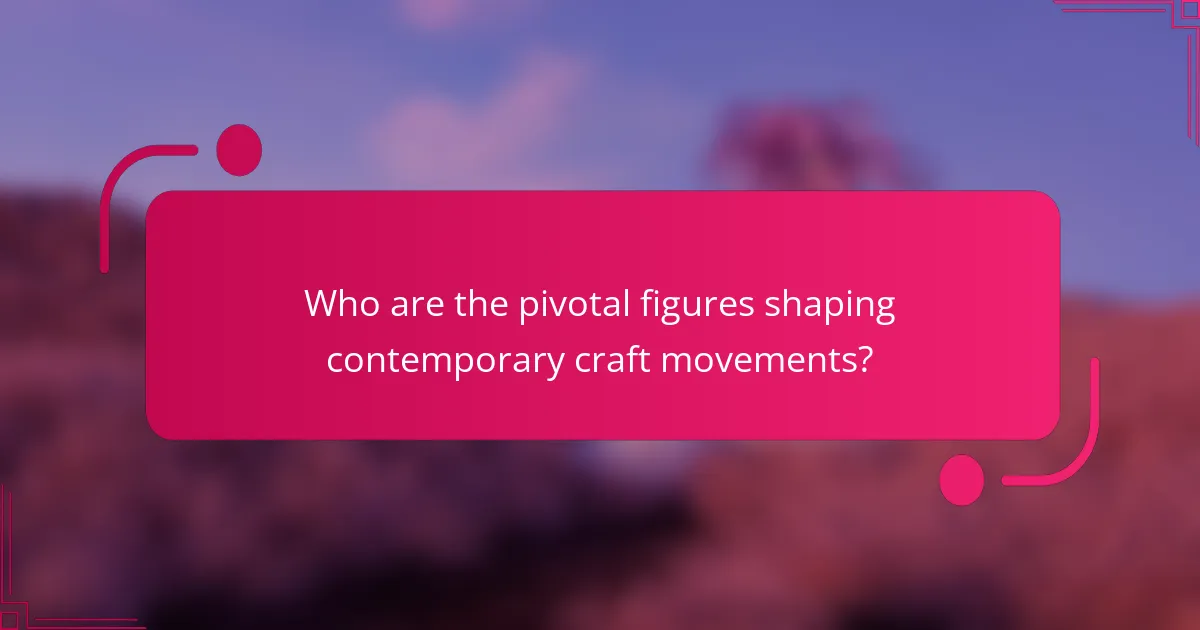
Who are the pivotal figures shaping contemporary craft movements?
Key figures shaping contemporary craft movements include artists, designers, and educators who challenge traditional boundaries. Notable individuals like Grayson Perry and El Anatsui redefine materials and techniques, impacting global craft dialogues. Their innovative approaches emphasize sustainability and cultural narratives, fostering a broader appreciation for craft as a vital art form. As a result, these figures inspire new generations and contribute to the resurgence of craft in contemporary art.
What contributions have artists from Canada made to contemporary craft?
Artists from Canada have significantly influenced contemporary craft through innovative techniques and cultural expressions. Their contributions reflect diverse backgrounds, integrating traditional practices with modern aesthetics. Notable figures include artists like Christine McLean and David Midwinter, who explore materials and forms that challenge conventional boundaries. Canadian artists often emphasize sustainability, using eco-friendly materials and methods, which resonates globally. This commitment to environmental consciousness distinguishes their work and fosters a broader dialogue on the role of craft in addressing contemporary issues.
How have British artisans impacted the evolution of craft movements?
British artisans significantly influenced contemporary craft movements by emphasizing traditional techniques and sustainable practices. Their commitment to craftsmanship has inspired a global resurgence in handmade goods. Key figures, such as William Morris, championed the Arts and Crafts Movement, advocating for quality over mass production. This focus on artistry and ethics continues to shape modern craft communities, promoting a deeper appreciation for heritage and innovation. The impact of British artisans is evident in the revival of local crafts and the integration of cultural identities into contemporary design.
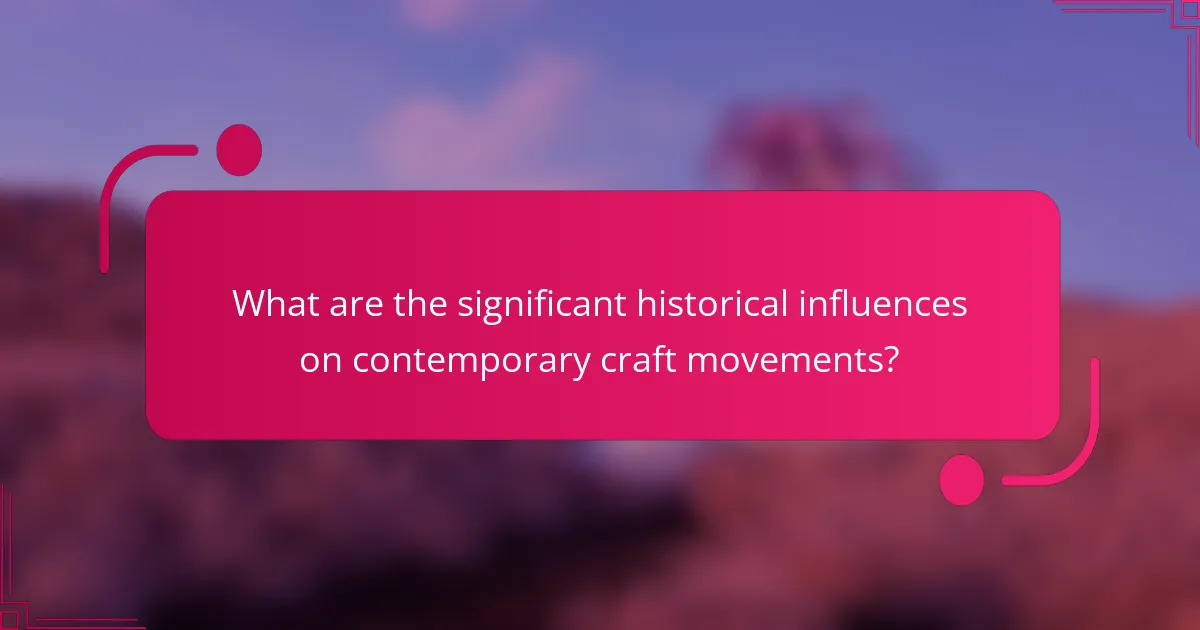
What are the significant historical influences on contemporary craft movements?
Contemporary craft movements are significantly influenced by historical events, cultural shifts, and key figures. The Arts and Crafts Movement of the late 19th century emphasized handmade quality, responding to industrialization. Post-World War II, the rise of studio crafts highlighted individual expression and creativity, with artists like Peter Voulkos redefining ceramics. Globalization has further diversified craft practices, integrating traditional techniques with contemporary aesthetics, fostering a rich tapestry of cultural exchange.
How did the Arts and Crafts Movement pave the way for contemporary practices?
The Arts and Crafts Movement significantly influenced contemporary practices by emphasizing craftsmanship and the value of handmade goods. This movement reacted against industrialization, advocating for quality and aesthetic appeal. Key figures like William Morris promoted design that integrated art with everyday life, inspiring modern artisans. The movement’s focus on sustainability and local materials resonates in current craft trends, fostering a global appreciation for unique, culturally-rooted creations.
Which cultural shifts in the 20th century have affected craft trends?
Cultural shifts in the 20th century significantly influenced contemporary craft movements. The rise of the Arts and Crafts movement emphasized handmade quality over industrial production, fostering a revival of traditional techniques. Post-World War II, the counterculture of the 1960s embraced DIY aesthetics, promoting individuality and personal expression in crafts. Globalization introduced diverse materials and techniques, enriching craft practices worldwide. Additionally, environmental awareness led to sustainable crafting methods, prioritizing eco-friendly materials and practices.
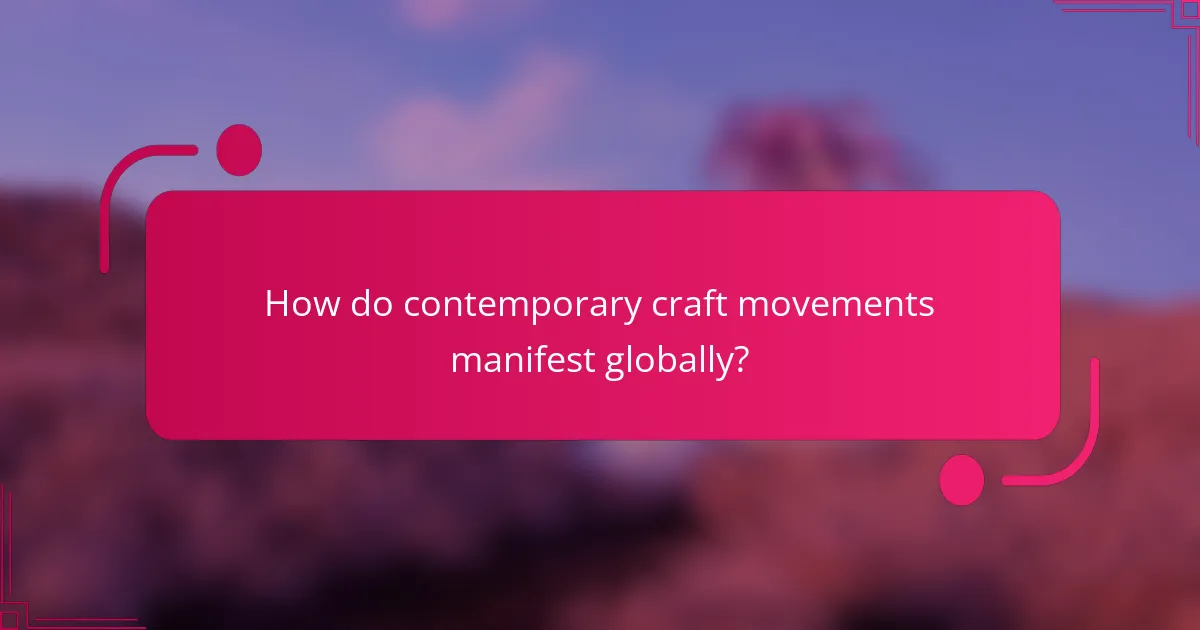
How do contemporary craft movements manifest globally?
Contemporary craft movements manifest globally through diverse expressions that reflect local cultures and global influences. These movements emphasize sustainability, community engagement, and the revival of traditional techniques.
Key figures, such as contemporary artisans and designers, play a crucial role in shaping these movements. They often blend traditional craftsmanship with modern aesthetics, creating unique pieces that resonate with today’s audiences.
The global impact of these movements is evident in how they foster cross-cultural exchanges. Events like international craft fairs and online platforms facilitate collaboration, allowing artisans from different backgrounds to share their work and ideas.
Additionally, contemporary craft movements challenge mass production by promoting handmade goods. This shift not only supports local economies but also raises awareness about the value of craftsmanship in a consumer-driven world.
What are the unique attributes of contemporary craft in the United States?
Contemporary craft in the United States features unique attributes such as innovation, sustainability, and community engagement. These movements emphasize personal expression and the blending of traditional techniques with modern aesthetics. Artists often focus on the use of reclaimed materials, showcasing a commitment to environmental responsibility. Additionally, the rise of digital technology has transformed crafting practices, enabling new forms of creation and collaboration.
How do Spanish craft traditions influence contemporary practices?
Spanish craft traditions significantly influence contemporary practices through techniques, materials, and aesthetics. These traditions emphasize artisanal skills and cultural heritage, inspiring modern artisans worldwide. For example, the use of ceramics from Talavera de la Reina showcases intricate designs that inform current pottery styles.
Key figures, such as contemporary Spanish designers, often draw from regional crafts, blending historical elements with modern functionality. This fusion creates unique pieces that resonate globally, highlighting the importance of preserving traditional craftsmanship.
The global impact of Spanish craft traditions is evident in the rising popularity of handmade goods, reflecting a growing appreciation for authenticity and sustainability. As a result, contemporary movements increasingly prioritize local craftsmanship, echoing Spain’s rich artistic legacy.
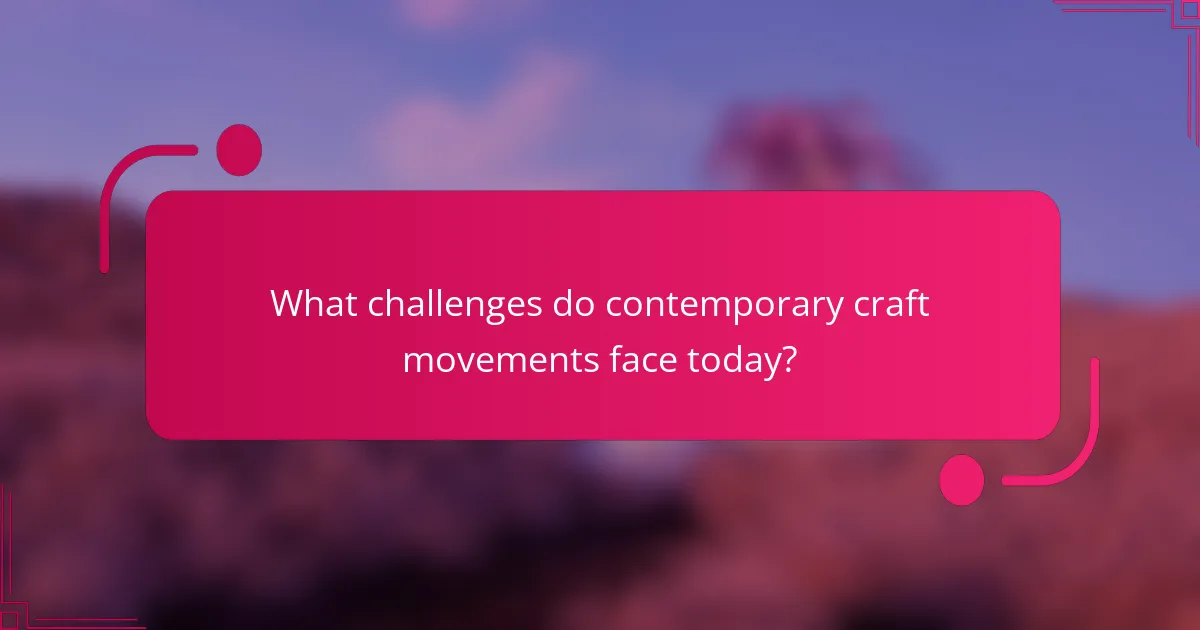
What challenges do contemporary craft movements face today?
Contemporary craft movements face challenges such as commercialization, sustainability, and the impact of technology. These issues threaten the authenticity and community focus inherent in traditional crafting practices.
Commercialization often pressures artisans to mass-produce, diluting unique craftsmanship. Sustainability remains a concern as materials and processes may not align with eco-friendly practices. Technology introduces both opportunities and challenges, as digital tools can enhance creativity but may also alienate traditional techniques.
Moreover, the global market creates competition that can overshadow local artisans. The rise of fast fashion and consumer culture further complicates the landscape for contemporary crafts. Artisans must navigate these challenges while striving to maintain their artistic integrity and cultural significance.
How does market demand affect the sustainability of craft practices?
Market demand significantly influences the sustainability of craft practices by driving consumer interest and financial viability. When demand for handcrafted goods rises, artisans can sustain and expand their practices. This demand often leads to innovation in materials and techniques, enhancing the craft’s relevance. For example, the growing trend towards sustainable and ethically sourced products has encouraged craftspeople to adopt eco-friendly practices, thereby aligning with consumer values. As a result, the intersection of market demand and craft sustainability fosters a dynamic ecosystem that supports both tradition and modernity.
What barriers do artisans encounter in promoting their work?
Artisans face several barriers in promoting their work, including limited access to markets, inadequate marketing skills, and insufficient financial resources. Many struggle with visibility in a saturated market, making it difficult to reach potential customers. Additionally, a lack of networking opportunities can hinder collaboration and support within the craft community. These challenges often limit the growth and sustainability of artisan businesses.
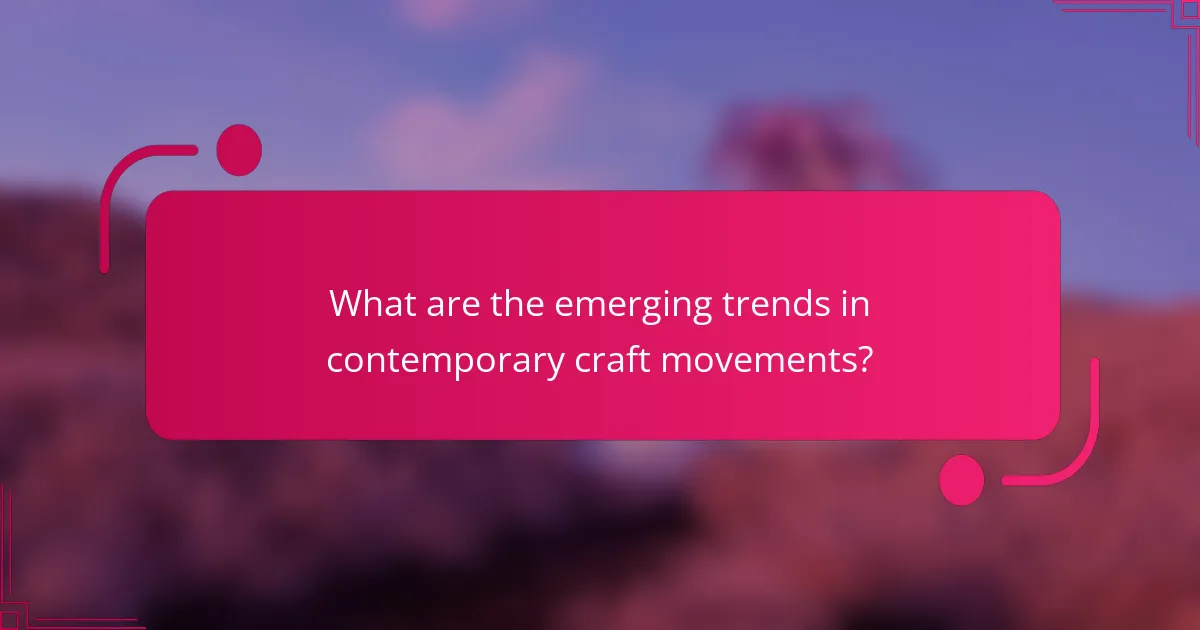
What are the emerging trends in contemporary craft movements?
Emerging trends in contemporary craft movements include a focus on sustainability, the integration of technology, and a resurgence of traditional techniques. These trends reflect a shift towards eco-conscious practices and innovative approaches in crafting.
Sustainability has become a central concern, with artisans prioritizing eco-friendly materials and processes. For instance, many craftspeople are using recycled or natural materials to minimize environmental impact.
Technology is reshaping craft through digital tools and platforms. Techniques such as 3D printing and online marketplaces allow craftsmen to reach broader audiences and experiment with new designs.
Additionally, there is a revival of traditional craftsmanship, with contemporary artisans blending age-old techniques with modern aesthetics. This fusion creates unique pieces that honor heritage while appealing to current tastes.
How are digital platforms transforming the craft landscape?
Digital platforms are revolutionizing the craft landscape by enhancing accessibility, collaboration, and visibility for artisans. Online marketplaces enable crafters to reach global audiences, while social media fosters community engagement and knowledge sharing. Platforms like Etsy and Instagram empower creators to showcase their work, expanding their customer base and influence. As a result, contemporary craft movements benefit from increased innovation and diversity, reflecting a broad array of cultural influences and practices.
What role do community workshops play in the future of craft?
Community workshops are crucial for the future of craft as they foster collaboration and innovation. These workshops create spaces for artisans to share skills and techniques, enhancing creativity and preserving traditional methods. They also facilitate community engagement, allowing diverse voices to contribute to contemporary craft movements. As a result, these gatherings can lead to new materials and forms of expression, enriching the craft landscape globally.
What best practices should artisans adopt to thrive in contemporary craft?
Artisans should adopt a customer-centric approach, embrace digital platforms, and prioritize sustainability to thrive in contemporary craft. Engaging with audiences through social media enhances visibility and builds community. Incorporating eco-friendly materials aligns with growing consumer demand for sustainability. Continuous skill development ensures artisans stay relevant in evolving markets. Collaboration with other creators fosters innovation and expands reach.
